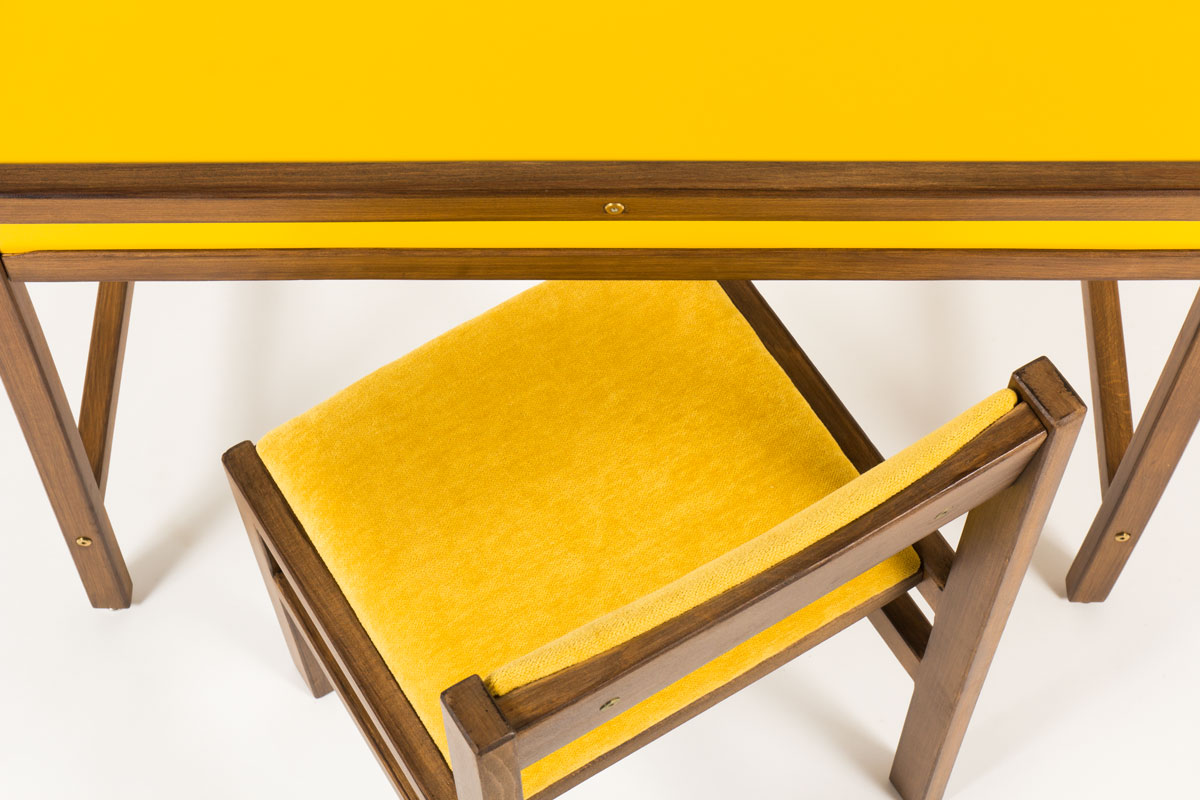Andre Sornay, avant-garde designer and cabinet maker
André Sornay was a renowned cabinetmaker from Lyon, an Art Deco designer whose vision perfectly combined the avant-garde spirit and the functional. Throughout his career, he never stopped moving away from the traditions of cabinet-making, breaking standards through his anti-conformist approach to the profession of furniture maker; he will have been able to develop innovative ideas perfected in rigorous systems without ever being locked in.

Console and chair set in tinted beech - Picture @Galerie44
1920 – 1930 : Avant-garde and Art Deco
Still new to his trade as a cabinetmaker when he took over the family business following the death of his father in 1919, the young André Sornay, just 17 years old, made a radical decision. The family business, then dedicated to the trade in fabrics and furniture, will now produce the furniture that he designed himself; furniture with modern and refined lines.

André Sornay, 29 years-old
Three years later, he launched himself by presenting his work at the furniture fair in Lyon. The overall feedback for the dining room is very positive; his architecture is called conscientious and people are seduced by its aesthetics as much as by its finishing work.
In 1923, the company then changed its name to become André Sornay and CIE; a way to mark his break with the family business which has remained very traditional, and to move towards a new, more modern identity. André Sornay now uses materials such as plywood, and he develops resolutely modernist lines with combinable furniture that opens a few doors to a new clientele. Each of his pieces remains unique, sometimes declined "in two or three copies depending on a particular request", but barely more.
The next few years will be flourishing for his business: he will add the skills of the best Lyon artists and establish his own production workshop in a factory located in Villeurbanne where he will employ ten carpenters and cabinet makers.
But at the end of the 1920s, the economic situation, which also affected the decorative arts, marked the end of this Art Deco period. André Sornay mobilizes all his genius to develop a new assembly system which will completely revolutionize his production method and become one of these hallmarks.
1930 – 1940 : The Studding
On August 10, 1932, he poses his first patent for the invention of the "furniture panel system and its method of assembly"; an ingenious system to respond to the crisis that affects the whole country. Production costs, thanks to the streamlining of the process, are reduced, allowing him to sell his furniture at much more affordable prices.
Its new assembly technique, "studding", allows veneer panels with fine essences to be assembled on a solid frame, using metal points made of copper, brass, iron, or even aluminum. The alignment of the nails necessary to hold the slab becomes a distinctive sign of André Sornay's furniture, and even a real decorative element.
Then follows a large production of "studded furniture" distributed in small series and accessible to the greatest number. André Sornay chose an intermediary path between the unique model of a Jacques-Emile Ruhlmann, and the mass distribution of a Maurice Dufrène.
In the mid-1930s, André Sornay gradually abandoned Macassar ebony to introduce Oregon pine; he will also be one of the rare designers of the 20th century - with the architect Eileen Gray and the bookbinder / assembler Pierre Legrain - to use this wood usually foreign to the world of classical cabinetmaking and whose use is limited essentially modernist production.
In 1937, he received the honor of representing the city of Lyon at the international exhibition of arts and techniques in modern life held in Paris, and was awarded the bronze medal for his personal office "de l 'assembler'.
Coffee table in oak, 1930 - Picture @Galerie44
1940 – 1960 : Post-war period
But in 1942, it was drama.
A fire ravaged part of the workshops and offices of Villeurbanne in an already difficult period for André Sornay who suffered the aftermath of the shortage of raw materials. Plywood stocks are running out, copper and brass are difficult to obtain ... it's a dark period for the designer.
He recovered by inventing, a few years later, a new assembly process even more revolutionary than the first. From 1953 to 1955, he worked tirelessly to develop his rapid assembly system for so-called "kit" furniture.
The "Sornay tigette" was born.

Tigette system, disassembled parts - Picture @Galerie44
Furniture is put together by assembling a rear frame fitted with threaded inserts intended to receive the famous tabs to which a front frame is fixed. The nailing process is far away, and André Sornay marks a real break with the traditions of cabinetmaking.
In 1960, he bowed out by leaving the company to his children who decided to publish furniture for communities.
Today
Following the acquisition of an important private collection of the designer, Galerie44 specialized in tigette furniture, a nice collection is presented in our special category Furniture André Sornay.

Andre Sornay furniture, 1960 - Photo @Galerie44
All the work of André Sornay would not be highlighted as much without the work and expertise of Alain Marcelpoil, creator of the Galerie Alain Marcelpoil in Paris specializing in André Sornay furniture from the Art Deco period.


